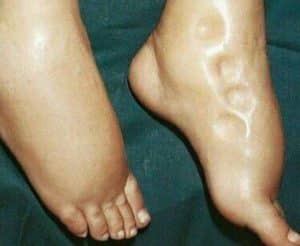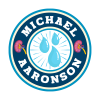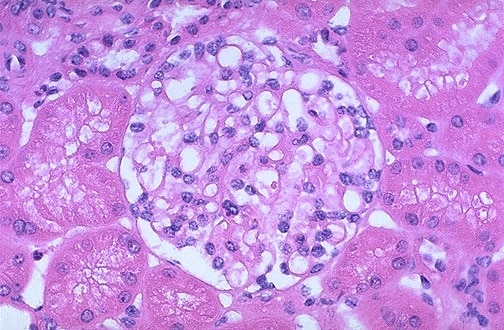Background: Patient with diagnosed minimal change disease recently started prednisone. Presents with swelling and needs edema treatment. Takes blood pressure medication. Has chronic kidney disease, CKD 3B, and an increased uACR of 3578.

The patient’s medications include: losartan 100 mg daily, amlodipine 5 mg daily, torsemide 10 mg daily, and prednisone.
The patient’s blood pressure is 145/92. The heart rate is 89.
The patient has signs of volume overload. There is bilateral lower extremity edema, elevated jugular venous pressure, and bilateral crackles on pulmonary examination.
A 2 gram per day salt goal has been suggested.
Please answer the following questions:
What is the primary treatment for minimal change disease in children?
A
Diuretics
B
Steroids
C
Antibiotics
D
Continue current support
Steroids
In which population does minimal change disease account for a higher percentage of nephrotic syndrome cases?
A
Adults
B
Elderly
C
Children
D
Infants
Children
What is a common characteristic of minimal change disease as observed in urinalysis?
A
Hematuria
B
Proteinuria
C
Glucosuria
D
Bacteriuria
Proteinuria
What is the primary mechanism contributing to hypertension in kidney disease?
A
Sodium retention
B
Decreased blood volume
C
Increased glomerular filtration rate
D
Increased potassium levels
Sodium Retention
Which type of diuretic is recommended for patients with declining glomerular filtration rate (GFR)?
A
Potassium-sparing diuretics
B
Thiazide diuretics
C
Loop diuretics
D
Carbonic anhydrase inhibitors
Loop diuretics
Discussion:
Minimal Change Disease, Swelling, and Hypertension Management
Minimal Change Disease (MCD)
Minimal Change Disease (MCD) is a common cause of idiopathic nephrotic syndrome in children, accounting for 70-90% of cases in children over one-year-old. It is characterized by proteinuria leading to edema and intravascular volume depletion, with a good response to steroids. MCD has a good prognosis in pediatric patients.
- Distinctive features: proteinuria, edema, intravascular volume depletion
- The response to treatment is good, particularly the response to steroids in pediatrics. If steroids fail, there are other options.
Management of Minimal Change Disease
The cornerstone treatment for MCD is steroids, with children often achieving remission within 4 weeks, compared to adults who may take longer. Relapse rates are high in both children and adults.
- Initial treatment: steroids, usually prednisone
- Children experience a quicker remission time (4 weeks) compared to adults.
- Relapse rates: high in both children and adults
Hypertension Management in Kidney Disease and Edema on ACE or ARB
The pathophysiology of hypertension in kidney disease involves sodium retention because of factors like reduced glomerular filtration rate (GFR) and increased renin-angiotensin-aldosterone system activity. Control of sodium balance is crucial in managing blood pressure in kidney disease.
- Recommended strategies: dietary sodium restriction (<2000 mg/d) and diuretic use
- Diuretics: loop diuretics are the preferred choice as eGFR declines
- Specific case above: hypervolemic patient requires increased loop diuretic dose. The current dose is not enough.
Case Management
In the case discussed, increasing the torsemide dose is the most appropriate action because of the patient’s chronic kidney disease (CKD) and albuminuria. The patient has nephrotic range proteinuria and needs higher dose torsemide.
- Correct action: increase torsemide dose
- Explanation of the other test options: increasing amlodipine dose can lead to an edema risk. Adding an ACE inhibitor to an ARB is not recommended. The patient is already on a salt restriction. Thiazide diuretics lose effectiveness as eGFR decreases. Fluid restriction to 1 liter per day is not sustainable.
Blood Pressure Goals
Current guidelines recommend a target blood pressure of <130/80 mm Hg for patients with hypertension and CKD. Individualized treatment based on shared decision making is crucial to achieve optimal blood pressure control.
- Some suggest blood pressure targets for the systolic as low as 120 mm Hg.
- We stress the importance of individualized treatment in hypertension management using shared decision making.
Related:
Quiz – Primary Membranous Nephropathy Treatment by Michael Aaronson MD, Lincoln Nephrology and Hypertension
Hypertension In Pregnancy 158/108 – Nephrology Test Question – Michael Aaronson, Lincoln Nephrology and Hypertension
Inspiration: Minimal Change Disease National Library of Medicine

